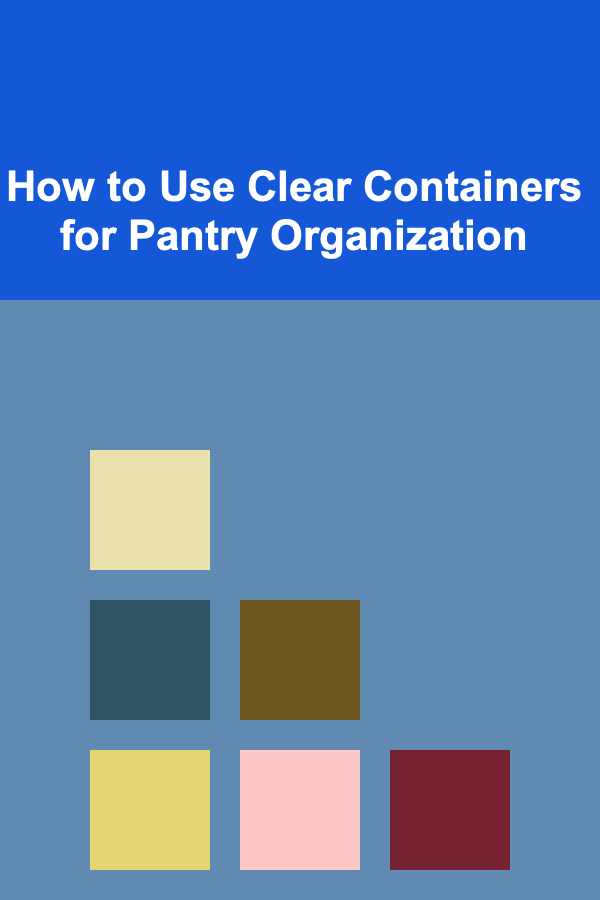
How to Use Clear Containers for Pantry Organization
ebook include PDF & Audio bundle (Micro Guide)
$12.99$11.99
Limited Time Offer! Order within the next:

In today's busy world, a well-organized pantry can be a game-changer. It not only streamlines meal preparation but also promotes healthier eating habits and reduces food waste. One of the most effective ways to achieve this organization is by using clear containers. This comprehensive guide will explore the benefits of clear containers, practical steps for implementation, creative ideas for their use, and expert tips to maintain an organized pantry.
The Importance of a Well-Organized Pantry
Before diving into the specifics of using clear containers, let's take a moment to understand why organizing your pantry is essential.
1. Increased Efficiency
An organized pantry allows you to quickly find what you need when cooking or preparing meals. This efficiency saves time and makes meal prep more enjoyable.
2. Reduced Food Waste
When you can easily see what ingredients you have, you're less likely to forget about them until they spoil. This visibility leads to reduced food waste and encourages thoughtful meal planning.
3. Encourages Healthy Eating
A tidy and organized pantry can inspire healthier eating choices. When nutritious options are visible and accessible, you're more likely to choose them over processed snacks.
4. Enhanced Aesthetics
Clear containers create a visually appealing pantry space. The uniformity and transparency of these containers lend a clean and sophisticated look to your kitchen.
5. Promotes Mindfulness in Cooking
When everything is organized, it's easier to engage with the cooking process mindfully, leading to better meal outcomes.
Benefits of Using Clear Containers
Using clear containers for pantry organization comes with numerous advantages:
1. Visibility
The primary benefit is visibility. Clear containers allow you to see at a glance what you have, making it easier to plan meals and grocery shopping.
2. Uniformity
Clear containers provide a uniform look that can create a cohesive and visually pleasing pantry. This uniformity can contribute to a more organized aesthetic.
3. Space-Saving
Many clear containers are designed to stack or nest, helping maximize vertical space in your pantry.
4. Easy Cleaning
Most clear containers are easy to clean, ensuring that spills and messes don't accumulate. They can often be washed by hand or placed in the dishwasher.
5. Versatility
Clear containers come in various shapes and sizes, accommodating different pantry items, from grains and snacks to spices and baking supplies.
Steps to Organize Your Pantry with Clear Containers
Now that we've established the importance and benefits of using clear containers, let's delve into the step-by-step process for organizing your pantry.
Step 1: Assess Your Current Pantry Setup
Before you start organizing, take a close look at your existing pantry setup:
A. Empty the Pantry
Clear out all items from your pantry. This step gives you a blank slate to work with and allows you to assess what you have.
B. Clean the Shelves
Wipe down all shelves and surfaces to eliminate dust, crumbs, or spills. A clean starting point enhances the overall organization process.
C. Inventory Check
Make an inventory of all food items, noting expiration dates and conditions. Discard anything expired or damaged.
Step 2: Declutter Your Pantry Items
Decluttering is crucial before reorganizing. Here's how to do it effectively:
A. Sort Items by Category
Group similar items together, such as:
- Grains (rice, pasta, quinoa)
- Canned goods
- Snacks
- Baking supplies
- Spices and herbs
B. Evaluate What You Have
Look through each category and make decisions on what to keep, donate, or discard:
- Keep: Usable items that you regularly consume.
- Donate: Non-perishable items that you won't use.
- Discard: Expired products or those that are no longer safe to eat.
Step 3: Choose the Right Clear Containers
Selecting the right containers is vital for effective organization:
A. Determine Sizes and Shapes
Consider the types of items you're storing and choose containers accordingly:
- Large Containers: Ideal for bulk items like flour, sugar, and pasta.
- Medium Containers: Suitable for grains, snacks, or cereals.
- Small Containers: Perfect for spices, dried fruits, or nuts.
B. Consider Materials
Clear containers typically come in glass or plastic. Each has its pros and cons:
- Glass: Durable and aesthetically pleasing; however, it's heavier and can break.
- Plastic: Lightweight and often more affordable; ensure it's BPA-free for safety.
C. Select Lid Types
Choose lid types based on your needs:
- Airtight Lids: Keep contents fresh and prevent pests.
- Flip-top Lids: Provide convenient access to frequently used items.
- Screw-on Lids: Offer secure closures for long-term storage.
Step 4: Label Your Containers
Labeling is an essential part of maintaining organization:
A. Choose Labeling Methods
You can opt for various methods of labeling:
- Sticker Labels: Simple and straightforward; choose waterproof options for longevity.
- Chalkboard Labels: Allow for easy re-labeling when contents change.
- Printed Labels: Create custom labels using templates or design software for a professional look.
B. Include Important Information
Labels should include:
- Item name
- Expiration date (if applicable)
- Quantity or serving size (for portion control)
Step 5: Arrange Your Containers Strategically
How you arrange your containers can significantly impact efficiency:
A. Categorize by Type
Group containers based on categories, such as:
- Grains
- Baking Supplies
- Snacks
- Spices
B. Use Shelving Wisely
If space permits, consider installing additional shelving to elevate containers. Store taller containers on lower shelves for easy access and shorter ones on higher shelves.
C. Utilize Vertical Space
Employ stackable containers or tiered organizers to maximize space. This approach keeps items organized while making everything visible.
Step 6: Create a Cleaning Routine
Maintaining a tidy pantry requires regular upkeep:
A. Daily Tasks
Incorporate daily cleaning tasks such as:
- Pick Up Spills: Clean any spills immediately to prevent mess buildup.
- Check for Expiration: Regularly check for items nearing expiration.
B. Weekly Tasks
Perform weekly tasks, including:
- Dusting Shelves: Dust all surfaces to keep the area clean.
- Reorganizing as Needed: Adjust container placement if certain items are accessed more frequently.
C. Monthly Deep Cleaning
Conduct monthly deep cleaning sessions to refresh your pantry. This should include:
- Disinfecting containers and shelves
- Washing any washable storage bins or baskets
- Restructuring supplies and decluttering as necessary
Creative Ideas for Using Clear Containers
Beyond standard pantry items, clear containers can be used creatively for various purposes:
1. Snack Station
Create a snack station with various clear containers filled with nuts, dried fruits, granola, or popcorn. This setup encourages healthy snacking while keeping items visible and accessible.
2. Baking Supply Organizer
Store baking essentials like flour, sugar, chocolate chips, and sprinkles in labeled clear containers. This arrangement makes it effortless to grab what you need when whipping up treats.
3. Spice Rack
Use small clear containers for spices and herbs. Arrange them alphabetically or by cuisine type for easy access when cooking.
4. Meal Prep Station
Prepare jars for meal prep by portioning out ingredients for specific recipes. For instance, store pre-measured quinoa, beans, and vegetables for easy assembly during cooking.
5. Craft Supplies
Repurpose clear containers in your pantry for craft supplies like buttons, ribbons, or beads. This setup keeps everything neat and organized in one location.
6. Tea or Coffee Station
Designate jars for different types of teas or coffee blends. Label each jar clearly and arrange them together for an appealing beverage center.
Common Challenges and Solutions
As with any organizational system, challenges may arise. Here are some common issues along with potential solutions:
Challenge 1: Overwhelming Clutter
Solution: If your pantry feels cluttered, break down the decluttering process. Focus on one section at a time to avoid feeling overwhelmed.
Challenge 2: Resistance from Family Members
Solution: Some family members may resist changes to the pantry. Introduce new storage solutions gradually and allow others to explore their area before fully integrating changes.
Challenge 3: Limited Space
Solution: Get creative with storage solutions. Utilize vertical space, under-bed storage, or multifunctional furniture to maximize space efficiency.
Challenge 4: Frequent Messes
Solution: Implement preventive measures, such as using washable covers on furniture, investing in machines designed to remove pet hair, or keeping cleaning supplies readily available.
Real-Life Examples of Organized Pantries
To inspire your organizational journey, here are a few real-life examples showcasing effective strategies:
Example 1: The Small Apartment Pantry
In a small apartment, pet owners use vertical shelving to keep cat toys and supplies neatly organized. Wall-mounted hooks hold leashes, while a compact bin stores food and treats. This setup maximizes limited square footage while keeping everything tidy.
Example 2: The Family-Friendly Pantry
A family with multiple pets has dedicated zones for each animal. Each zone contains personalized baskets for toys, food, and grooming supplies. Color-coded labels help children locate items quickly, promoting engagement in pet care.
Example 3: The Stylish Pantry
In a modern home, a pantry features a chic pet bed and stylish storage solutions that match the home decor. Decorative baskets house toys, while a curated selection of pet-friendly books adds fun flair to the space.
Conclusion
Keeping your pantry organized using clear containers is a simple yet powerful strategy to optimize your kitchen space. By enhancing visibility, improving aesthetics, and promoting hygiene, clear containers can revolutionize how you manage pantry supplies.
Follow the steps outlined in this guide---from assessing your current setup to incorporating smart storage solutions---and you'll create a functional, inviting space that enhances your cooking experience.
Remember that maintaining an organized pantry is an ongoing process. Regularly reassess your system, involve family members, and adapt to changing needs. With the right strategies, you can enjoy a clean and harmonious home that reflects your love for cooking and organization. Happy organizing!

How to Create a Monthly Reading Challenge in Your Library
Read More
How to Create a Software Implementation Checklist for Success
Read More
How to Secure Your Home When You Live in a Rental
Read More
How to Set Up Your Amazon Seller Account for Custom Products
Read More
How to Soundproof a Bathroom for Privacy
Read More
10 Tips for Writing Haiku Poetry
Read MoreOther Products

How to Create a Monthly Reading Challenge in Your Library
Read More
How to Create a Software Implementation Checklist for Success
Read More
How to Secure Your Home When You Live in a Rental
Read More
How to Set Up Your Amazon Seller Account for Custom Products
Read More
How to Soundproof a Bathroom for Privacy
Read More